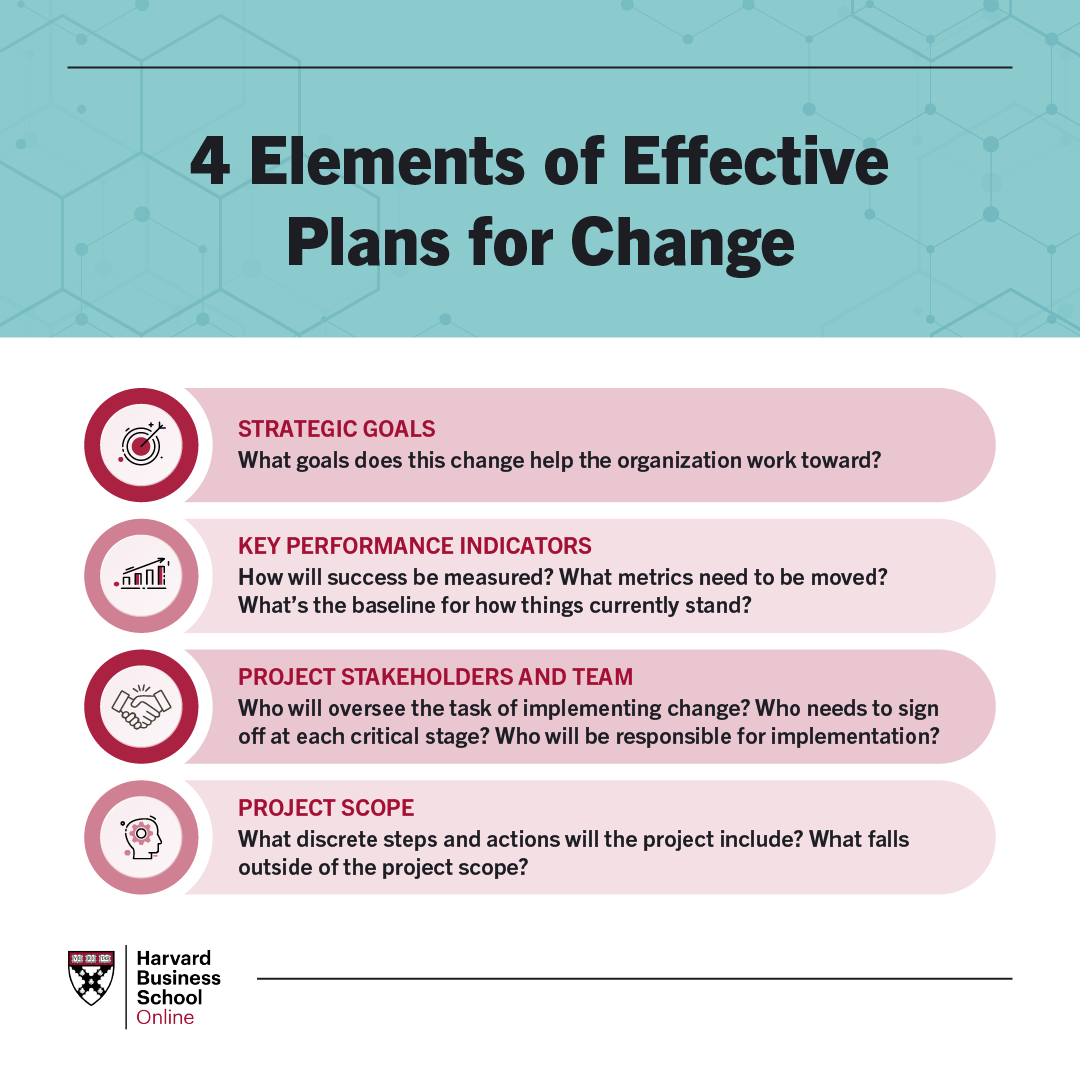

Businesses must constantly evolve and adapt to meet a variety of challenges—from changes in technology, to the rise of new competitors, to a shift in laws, regulations, or underlying economic trends. Failure to do so could lead to stagnation or, worse, failure.
Approximately 50 percent of all organizational change initiatives are unsuccessful, highlighting why knowing how to plan for, coordinate, and carry out change is a valuable skill for managers and business leaders alike.
Have you been tasked with managing a significant change initiative for your organization? Would you like to demonstrate that you’re capable of spearheading such an initiative the next time one arises? Here’s an overview of what change management is, the key steps in the process, and actions you can take to develop your managerial skills and become more effective in your role.
Free E-Book: How to Become a More Effective Leader
Access your free e-book today.
Organizational change refers broadly to the actions a business takes to change or adjust a significant component of its organization. This may include company culture, internal processes, underlying technology or infrastructure, corporate hierarchy, or another critical aspect.
Organizational change can be either adaptive or transformational:

Change management is the process of guiding organizational change to fruition, from the earliest stages of conception and preparation, through implementation and, finally, to resolution.
As a leader, it’s essential to understand the change management process to ensure your entire organization can navigate transitions smoothly. Doing so can determine the potential impact of any organizational changes and prepare your teams accordingly. When your team is prepared, you can ensure everyone is on the same page, create a safe environment, and engage the entire team toward a common goal.
Change processes have a set of starting conditions (point A) and a functional endpoint (point B). The process in between is dynamic and unfolds in stages. Here’s a summary of the key steps in the change management process.
Check out our video on the change management process below, and subscribe to our YouTube channel for more explainer content!
For an organization to successfully pursue and implement change, it must be prepared both logistically and culturally. Before delving into logistics, cultural preparation must first take place to achieve the best business outcome.
In the preparation phase, the manager is focused on helping employees recognize and understand the need for change. They raise awareness of the various challenges or problems facing the organization that are acting as forces of change and generating dissatisfaction with the status quo. Gaining this initial buy-in from employees who will help implement the change can remove friction and resistance later on.
Once the organization is ready to embrace change, managers must develop a thorough, realistic, and strategic plan for bringing it about.

The plan should detail:
While it’s important to have a structured approach, the plan should also account for any unknowns or roadblocks that could arise during the implementation process and would require agility and flexibility to overcome.

After the plan has been created, all that remains is to follow the steps outlined within it to implement the required change. Whether that involves changes to the company’s structure, strategy, systems, processes, employee behaviors, or other aspects will depend on the specifics of the initiative.
During the implementation process, change managers must be focused on empowering their employees to take the necessary steps to achieve the goals of the initiative and celebrate any short-term wins. They should also do their best to anticipate roadblocks and prevent, remove, or mitigate them once identified. Repeated communication of the organization’s vision is critical throughout the implementation process to remind team members why change is being pursued.
Once the change initiative has been completed, change managers must prevent a reversion to the prior state or status quo. This is particularly important for organizational change related to business processes such as workflows, culture, and strategy formulation. Without an adequate plan, employees may backslide into the “old way” of doing things, particularly during the transitory period.
By embedding changes within the company’s culture and practices, it becomes more difficult for backsliding to occur. New organizational structures, controls, and reward systems should all be considered as tools to help change stick.
Just because a change initiative is complete doesn’t mean it was successful. Conducting analysis and review, or a “project post mortem,” can help business leaders understand whether a change initiative was a success, failure, or mixed result. It can also offer valuable insights and lessons that can be leveraged in future change efforts.
Ask yourself questions like: Were project goals met? If yes, can this success be replicated elsewhere? If not, what went wrong?
While no two change initiatives are the same, they typically follow a similar process. To effectively manage change, managers and business leaders must thoroughly understand the steps involved.
Some other tips for managing organizational change include asking yourself questions like:

If you’ve been asked to lead a change initiative within your organization, or you’d like to position yourself to oversee such projects in the future, it’s critical to begin laying the groundwork for success by developing the skills that can equip you to do the job.
Completing an online management course can be an effective way of developing those skills and lead to several other benefits. When evaluating your options for training, seek a program that aligns with your personal and professional goals; for example, one that emphasizes organizational change.
Do you want to become a more effective leader and manager? Explore Leadership Principles, Management Essentials, and Organizational Leadership—three of our online leadership and management courses—to learn how you can take charge of your professional development and accelerate your career. Not sure which course is the right fit? Download our free flowchart.
This post was updated on August 8, 2023. It was originally published on March 19, 2020.

We offer self-paced programs (with weekly deadlines) on the HBS Online course platform.
Our platform features short, highly produced videos of HBS faculty and guest business experts, interactive graphs and exercises, cold calls to keep you engaged, and opportunities to contribute to a vibrant online community.
We expect to offer our courses in additional languages in the future but, at this time, HBS Online can only be provided in English.
All course content is delivered in written English. Closed captioning in English is available for all videos. There are no live interactions during the course that requires the learner to speak English. Coursework must be completed in English.
No, all of our programs are 100 percent online, and available to participants regardless of their location.
Certificate Programs
HBS Online welcomes committed learners wherever they are—in the world and their careers—irrespective of their professional experience or academic background. To extend the reach of HBS Online, we no longer require an application for our certificate programs. (Applications are still required for our credential programs: CORe and CLIMB.) You can now immediately enroll and start taking the next step in your career.
All programs require the completion of a brief online enrollment form before payment. If you are new to HBS Online, you will be required to set up an account before enrolling in the program of your choice.
Our easy online enrollment form is free, and no special documentation is required. All participants must be at least 18 years of age, proficient in English, and committed to learning and engaging with fellow participants throughout the program.
Updates to your enrollment status will be shown on your account page. HBS Online does not use race, gender, ethnicity, or any protected class as criteria for enrollment for any HBS Online program.
Credential Programs
HBS Online's CORe and CLIMB programs require the completion of a brief application. The applications vary slightly, but all ask for some personal background information. You can apply for and enroll in programs here. If you are new to HBS Online, you will be required to set up an account before starting an application for the program of your choice.
Our easy online application is free, and no special documentation is required. All participants must be at least 18 years of age, proficient in English, and committed to learning and engaging with fellow participants throughout the program.
Updates to your application and enrollment status will be shown on your account page. We confirm enrollment eligibility within one week of your application for CORe and three weeks for CLIMB. HBS Online does not use race, gender, ethnicity, or any protected class as criteria for admissions for any HBS Online program.